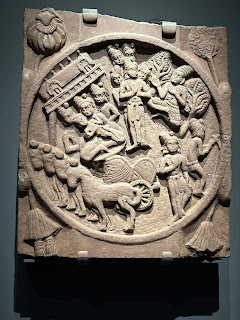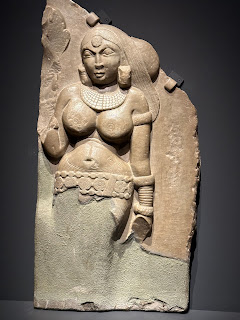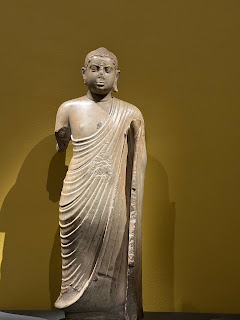Tree & Serpent: Early Buddhist Art in India
The Tree & Serpent exhibit at the Metropolitan Museum in New York, spanning 200 BCE to 400 CE, tells the fascinating story of 600 years of Buddhist art through 125 rare sculptures, some seen in public for the first time. They are from private collections in Europe, the U.K. and the U.S. but the majority are on loan from India — intricately crafted in limestone for the most part but also sculpted from bronze, gold, ivory, red sandstone, rock crystal, and silver.
Yakshas and Nagas
The exhibit shows the early indigenous origins of Buddhist imagery, going back to pre-Vedic nature cults of ancient rural India — to the yakshas (tree spirits) and the nagas (snake spirits). Many sculptures feature hooded snake motifs and trees; hence, the title: Tree & Serpent.
Just as early Christianity included pagan icons, Buddhism was open to and accepting of older established beliefs. The yakshas are usually considered benevolent caretakers of nature and were worshipped before the Vedic period whereas the yakshis were symbols of fertility. In some sculptures, the nagas, known as guardian spirits, become a shield of protection and resemble a canopy of umbrellas. The fig tree is another popular motif because it is said to have sheltered the Buddha during his meditation; hence it came to be associated with bodhi, or wisdom.
New Interpretations
In the nineteenth century and earlier, the study of Buddhism in India was driven largely by Western scholars of Sanskrit and Indologists who brought their own interpretations. Much of it was text-based, including the study of inscriptions found on stupas (funerary mounds) and viharas (monasteries) in northern India (Uttar Pradesh, Bihar, and Madhya Pradesh). This exhibit attempts to broaden that focus and shows us how Buddhism was actually practiced in this early period. Some of the most spectacular objects come from southern India (Andhra Pradesh).
The storytelling or narrative structure of Buddhist art is also reflected. Most of the teachings, as recorded in the sutras (discourses) are in the form of a disciple posing a question, and the Buddha responding. These sutras were memorized by the Buddha’s disciples and later written down, both in Pali and Sanskrit.
Stupas
The narrative structure reflected in the exhibit also replicates the form of a stupa that contained the Buddha’s remains. A stupa signals the presence of the Buddha through the relics and is the focus of daily worship.
There are not many Buddhas in this rather unusual exhibit! When one enters, what you see is the aniconic phase where Buddha is not viewed in human form. He is represented symbolically: a riderless horse, footprints (Buddha pada), the wheel of his teachings (the eight-spoked dharma chakra), an empty throne under a tree, a kneeling deer, and the relic container. Not until the final room does a free-standing Buddha appear!
Buddha in Human Form
According to some scholars, it was not until six centuries after his death that the Buddha was depicted in human form under the Kushan kings of Gandhara when Buddhism was impacted and modified by external influences: from China, Greece, and Persia. The form of Buddhism adopted by the Kushans included the veneration of Greek, Indian, and Zoroastrian deities.
There are scholars who object to terms such as aniconic or iconic when referring to Buddhist art. They argue that these terms were introduced by Western academics, that they derive from Abrahamic (not South Asian) religious traditions, and may not be appropriate to the understanding of Buddhism. Some of these interpretations include the suggestion that the Buddha was a god which is — of course — a complete negation of his teachings!
Trade with Rome
Two objects on display prove that a thriving trade existed with Rome. The first is a Roman bronze of the sea deity, Poseidon, excavated in 1944 (with other metal Roman items) in the town of Kolhapur, near Pune, Maharashtra. The second is a beautifully carved ivory figurine of a young woman of Indian origin (probably a courtesan) clad only in jewelry. Although made in India’s western Deccan region, she was discovered during the 1938 excavation of a Roman villa in Pompeii which was buried when the volcano erupted in 79 CE. In 1973, a companion figurine to the woman was excavated in central India, demonstrating that the region had a flourishing ivory trade with the Roman Mediterranean.
Kudos to the Met!
The Met deserves praise for doing such a superb job of curating, mounting, and lighting the objects. A conceptual stupa at the physical center has a stupa drum and railing with a path that allows visitors to walk around. The exhibition rooms radiate around the stupa. The relics displayed here are from Piprahwa, excavated in 1898 near Buddha’s birthplace of Lumbini (Western Nepal today). These may be the most precious relics ever found in Buddhist India. Soft chanting in the background piped into the enclosure helps to enhance the sense of quiet meditation.
Why did Buddhism Decline in India?
There are several theories about why Buddhism so completely disappeared from the land of its birth. The resurgence of Brahmanical Hinduism by the 10th century was one of the chief reasons. As Vaishnavism and Shaivism became popular, upper caste Hindus pursued a relationship with the ruling families and persuaded them to adopt Hinduism as the state religion. Later Gupta kings may have taken this a step further and persecuted Buddhists.
Other reasons include the emergence of multiple sects and the collapse of merchant and craft guilds that once patronized the monasteries and ensured the spread of the religion with the building of stupas and viharas.
Most importantly, the monasteries had amassed wealth (in contradiction to the Buddha’s teachings), thus becoming a prime target for Afghan invaders from Ghazni and Ghor. Between the 10th and 12th centuries, their attacks caused the demolition of the famous universities of Vikramshila and Nalanda and the slaughter of many Buddhist scholars.
Monks fled to Nepal, Tibet, and South India to escape pillage and death. After the monasteries were destroyed, the land was taken over by new rulers, thus blocking the return of the sangha (monastic order). Remaining lay Buddhists were incorporated into Hindu tradition. Soon after, a branch of Brahminical Hinduism began to proclaim that the Buddha was the ninth avatar (incarnation) of the Hindu deity, Vishnu, contributing further to the demise of a once great religion. It should be noted that Buddhism rejects the formal rituals, caste system, and priests of Hinduism but perhaps the most important difference is the rejection of the idea of a creator god.
Art Professor
I went to the exhibit with Alakananda “Alka” Mukerji of Manhattanville College, a private university in Purchase, NY. I met her at a reception in the Indian Consulate General. She is professor and chair of the Manhattanville College Studio art department and a prolific painter herself (see below weblink).
Alka pointed out an intriguing feature in the sculptures. Some of the women have thick bands or bracelets around their ankles, going halfway up their legs. If nothing else, the movement of these women would have been seriously impeded and we were wondering if these (metal or wooden) bands were merely decorative or a sign of oppression and control.
Alka looks for talented artists at museums whom she recruits to teach her students to draw. We ran into one such creative person, Dwight LaMarr Denorgé Williams of Tennessee who was expertly sketching European sculptures in a corner and selling reproductions of his work. Check him out below.
Ludi Joseph
New York
October 8, 2023
Weblink to Alka’s artworks:
http://alakanandamukerji.com/w/
 |
| Naga Mucalinda Pillar, Pauni, Mahar. |
 |
| Pillar Medallion, Bharhut, M.P. |
 |
| Yakshi, Amaravati, A.P. |
 |
| Yaksha Padmanidhi, Nagarjunakonda, A.P. |
 |
| Flaming Pillar, Nagarjunakonda, A.P. |
 |
| Royal Worshipper, Amaravati, A.P. |
 |
| Indian Girl Excavated at Pompeii, Ivory |
 |
| Dharm Wheel, Bharhut Stupa, M.P. |
 |
| Stupa Drum Panel, Nagarjunakonda, A.P. |
 |
| Lion Capital, Kushana, Mathura, U.P. |
 |
| Frieze from Phanigiri Monastery, Telengana |
 |
| Veneration of the Buddha as a religious icon |
 |
| Buddha in Human Form |
 |
| Artist Dwight Williams Displaying Benzoni Sketch |






